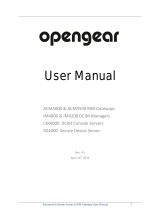
Table 18. Parameters file
Protocol communication parameters Description
wsman.timeout
Use to input WSMan timeout value in seconds. Default
timeout value is 60 seconds.
wsman.retries
Use to input the number of times a WSMan request must be
sent when a timeout occurs. Default retry value is 2.
NOTE:
You can configure the user macros, snmp.community, wsman.username, and wsman.password in the file
dell_resources.cfg available at the location: <NAGIOS_HOME>/dell/resources/
Discovering Dell EMC devices
You can discover all the supported Dell EMC devices using this plug-in.
Prerequisites:
● If you are using SNMP protocol for discovery, ensure that SNMP version 1 or SNMP version 2 are enabled, community string
is set and configured for Servers or Dell EMC Storage devices. For more information see Appendix.
● A secured network connectivity is established between Nagios Core and the device.
● It is recommended that the device must have a resolvable FQDN.
● WSMan is enabled and configured for discovering Dell EMC Chassis devices.
● If you are using WSMan protocol, it is recommended that you use non-default account credentials.
To discover Dell EMC devices:
1. Log in to Nagios Core with Nagios administrator privileges.
2. Navigate to the directory <NAGIOS_HOME>/dell/scripts
3. Run the Dell Device Discovery Utility with the option: perl dell_device_discovery.pl -h
The script syntax and information on options are displayed. For more information see About Dell Discovery Utility.
Based on your requirement do the following:
NOTE:
Before running the utility, ensure that you have updated protocol related information, for more information see
About Protocol Parameters.
To discover a device using an IP address or FQDN:
● perl dell_device_discovery.pl -H <IP address or FQDN name>
To discover using subnet with mask:
● perl dell_device_discovery.pl -S <Subnet with mask>
An example format for subnet with mask: 11.98.149.0/24
To discover using a list of IP addresses present in a file:
● perl dell_device_discovery.pl -F <IP address list file>
● For the -P option, Opt for a protocol:
NOTE: Ensure that the IP list that you provide in the file is new-line separated.
4. When prompted to confirm the discovery of the Dell EMC device (s), press Y and then Enter to continue. To exit the
discovery process, press any other key followed by Enter or press Enter to exit.
5. Once the discovery utility script is run, verify the Nagios configuration by running the command <NAGIOS_HOME>/bin/
nagios -v /usr/local/nagios/etc/nagios.cfg.
6. Ensure that no errors are present and then restart Nagios Core by running the command service nagios restart.
Device discovery and inventory
17




















